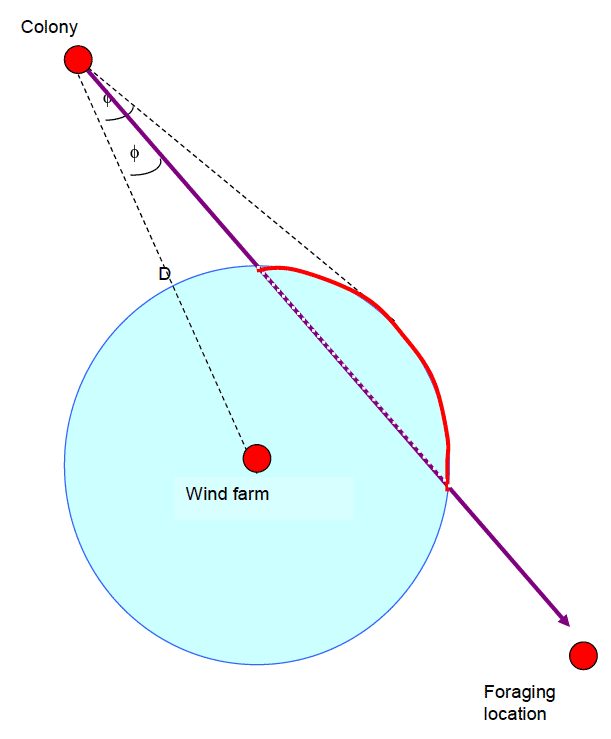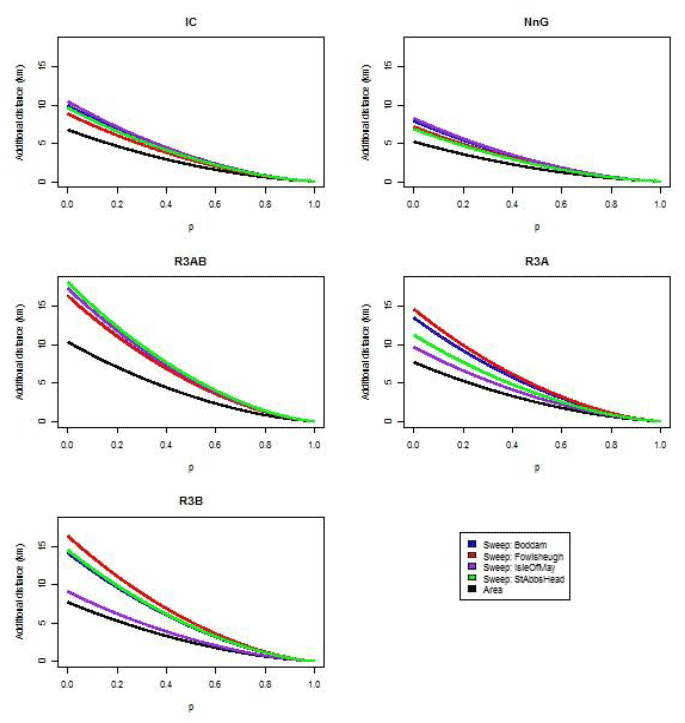Scottish Marine and Freshwater Science Volume 5 Number 13: Population consequences of displacement from proposed offshore wind energy developments for seabirds breeding at Scottish SPAs
Report on a project which aimed to develop a model to estimate the population consequences of displacement from proposed offshore wind energy developments for key species of seabirds breeding at SPAs in proximity to proposed Forth/Tay offshore wind farm d
Appendix G. Differences between the full and fast models
1) the fast model is substantially faster than the full model to run, and can therefore be used to explore new scenarios, or to run sensitivity analyzes, much more readily than the full model
The fast model is written so that all calculations are performed simultaneously on all birds by applying formulae to vectors or arrays; this is substantially faster than using for and if loops to model the fate of each individual, but is more restrictive and less flexible in terms of the forms of behaviour that can be captured by the model.
2) the full model allows birds to visit a different location if they will fail to meet their daily energy requirements ( DER) by visiting their original location; the fast model does not
In the full model, birds favour more trips over less trips, attempting to make first 3, then 2 and then 1 trip per time step. If a bird cannot meet its daily energy expenditure ( DEE) in 3, 2 or 1 trips, it then completes 2 trips for that day. The first trip is conducted at the chosen foraging location for that bird and will result in the bird not meeting its DEE for approximately half of the time step. The second trip is taken randomly from another bird that did meet its DEE successfully in 2 trips at an alternative location - so the second half of the time step results in the bird doing somewhat better in terms of meeting its DEE than if it had stayed at the same, original location. This is done to represent how birds move to new foraging locations if they find they are not able to meet their DEE at one location, perhaps using public information from other successful birds to direct the outward foraging trip from the colony.
In the fast model, birds favour more trips over less trips as described above, attempting to make first 3, then 2 and then 1 trip per time step. However, if a bird cannot meet its DEE in 1 trip it then does not complete a second trip for that time step, but merely remains at the original foraging location and forages for as long as it chooses before returning to the colony (subject to various foraging rules explained in Section 2.2). The reason for this difference is the large penalty in terms of computing time that is associated with selecting randomly from a different bird that did complete two trips successfully. Overall, we felt this was the best compromise between maintaining computing speed in the simpler model whilst trying to most faithfully represent the mechanisms in the full model.
3) the fast model does not include any mechanism for estimating cumulative effects
It would be possible in principle to incorporate such effects into the model, in the same way that they enter into the full model, and this is not likely to add substantially to the computational power required to run the model. The time required to add this to the code would be substantive, however, and it was not possible to do this within the timescale of this project.
4) the fast model matches birds between scenarios, so that the assessments of a wind farm quantify the impact of the wind farm on a particular set of birds (rather than comparing a set of birds that have been impacted by the wind farm against a different set of birds that have not)
Matching increases the precision for estimates of the impact of the wind farm, without incurring any substantive computational cost. It is achieved by ensuring that stochastic decisions which are not affected by the wind farm are identical in those model runs which include a wind farm and those model runs that do not. This is done within the fast model by setting the seed to be the same in both runs. This cannot be done in the full model because the model is coded in such a way that decisions related to the wind farm are not easily separated from other decisions.
5) the split in time between time on the nest and time resting at sea is slightly more realistic in the fast model than the full model;
The time adults would choose to spend unattending the nest differs subtly in each model. In the full model, if a bird has met its DEE and spent 50% of the time step at the colony, any remaining time is split 50:50 between attending the nest and resting at sea. However, in the fast model, a bird in this state will spend all remaining time at the nest, with only one hour spent resting at sea. This means the fast model allows for partnered birds to compensate slightly more for one another in terms of nest attendance than in the full model. This is a model refinement we chose to enact in the later, fast model because we felt it was more biologically realistic than the way in which this behaviour was coded in the original full model.
6) the fast model allows for variation in initial mass between adult birds;
Adult birds in the full model all start off each simulation at the same mass - this mass is the average mass recorded for the species from local empirical data. However, in the fast model, the starting masses for all adults are drawn from a distribution characterised by the mean and standard deviation of local empirical data for each species. The reason for this difference is simply that we felt drawing masses from a distribution would more realistically capture the reality of bird masses for each population, however, this change was difficult to enact in the full model because of processing time required to match up starting and end masses of individual birds. This problem was not an issue in the fast model because of the array structure of the model code.
7) the fast model uses a higher spatial resolution than the full model (0.5 x 0.5km rather than 1.67 x 1.67km);
Computational constraints restricted us to using a relatively coarse spatial resolution within the full model, but the reduced computational cost of the fast model allowed us to adopt a higher spatial resolution. The key advantage of the higher spatial resolution should be a more accurate description of the boundaries of the wind farms.
8) the fast model includes barrier effects in a more realistic way than the full model;
The full model assumes that the additional distance incurred as a result of barrier effects could be simulated from a normal distribution with a mean of 20km and a standard deviation of 5km. This can justified as being a "worst case scenario", but there are a number of limitations to this approach:
1) 20km is overly conservative in most situations;
2) it does not allow for the different sizes of different wind farms;
3) it does not allow for heterogeneity in the extent to which birds have to cross wind farms in order to reach their destination;
4) it does not allow for the variation in shapes of wind farms;
5) it does not allow for uncertainty about how birds actually respond to wind farms.
The fast model incorporates a revised approach that attempts to deal with the first three of these limitations. The fourth limitation is difficult to deal with from a technical perspective, and we did not have sufficient information to be able to deal with the final limitation.
The revised approach calculates the additional distance that a bird incurs in avoiding a wind farm using geometric calculations. It is based on two assumptions:
1) wind farms can be approximated by a circle;
2) in the absence of a wind farm birds will fly in a straight line; if their route passes through a wind farm they will adjust to this by flying around the perimeter of the wind farm using the shortest possible route.
In Figure G. 1 the bird would originally have taken the purple line from the colony to the foraging location, but the wind farm forces it to abandon part of this route (shown with red dots) and to fly around the perimeter of the wind farm (the route shown in red) instead.
The radius of the circle is defined by calculating (maximum bearing from colony that would hit a location in the wind farm - minimum bearing from colony that would hit a location in the wind farm).
The magnitude of the barrier effect depends on three quantities:
a) the distance from the colony to the centre of the wind farm ( D)
b) difference between the bearing from the colony to the centre of the wind farm and the edge of the wind farm ()
c) the relative angle at which the line from the colony to the foraging location hits the wind farm ( p)
The additional distance incurred as a result of the barrier effect is equal to

where

p represents the relative angle from the colony to the foraging destination, in relation to the wind farm. If p = 0 the line from the colony to the foraging destination passes straight through the middle of the wind farm (and the maximum barrier cost is incurred). If p = 1 the line from the colony to the foraging destination just grazes the edge of the wind farm (and the barrier cost is zero).
We have estimated the distribution of additional flight costs in relation to p for each wind farm, shown in Figure G. 2. This figure shows that 20km is an appropriate maximum to represent the worst case at the larges wind farm, but the average barrier distances are considerably lower. Since the main effect on adult and chick survival has resulted from barrier effects (in particular with puffins), this new method of calculating barrier effects will reduce the effect sizes.
Figure G. 1. Illustration of method of calculating barrier effects. See main text for full details.

Figure G. 2. Distribution of additional flight costs in relation to angle swept (relative to total angle swept by wind farm). See main text for details.

9) the fast model displaces birds into Zones 3 and 5 (the 5km buffer zone around each wind farm) in proportion to the estimated density of birds in those zones. This is in contrast to the full model, which displaces birds randomly into Zones 3 and 5 with no relation to the estimated bird density in those areas;
The reason for this difference is simply that we felt it more ecologically viable that birds would choose a new foraging location in relation to the suitability of available foraging locations within the 5km buffer around each wind farm. The consequence of this change is that under homogeneous prey the fast model will tend to estimate larger wind farm effects than the full model because it will tend to concentrate displaced birds into regions within the 5km buffer with high predicted bird density. Under homogeneous prey conditions these regions will not contain correspondingly high levels of prey, and so displaced birds may suffer greater interference competition that they would if they were more evenly distributed across the 5km buffer as occurs in the full model. However, given the lack of data on the displacement behaviour of birds and subsequent choices of foraging location it is impossible to assess which model incorporates the more realistic method for redistributing displaced birds to new foraging locations.
Contact
There is a problem
Thanks for your feedback